Review: Weeylite Ninja 400 & Godox VL150
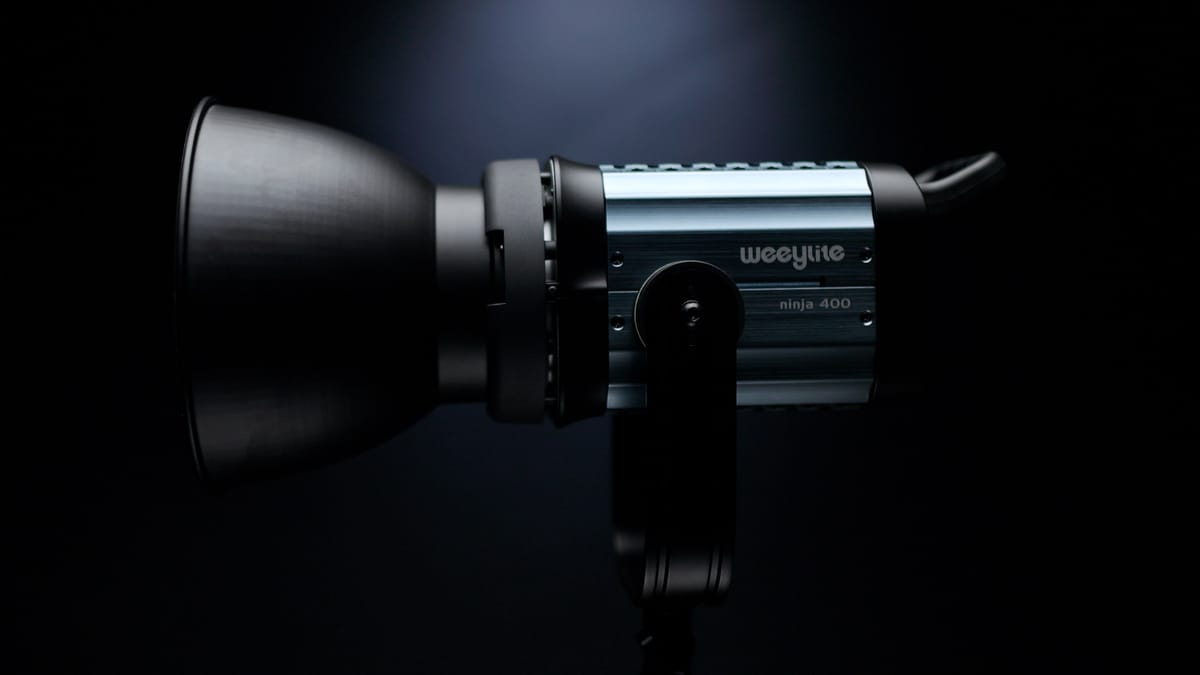
When building out a creative studio for photography or video, a bright continuous LED light is one of the most important hardware investments.
Buying the right LED light can be tricky, for there are different types, with different features, sold at prices hundreds of dollars apart. You don’t want to spend more than you need to, but you don’t want to underspend either.
In this review, I’ll be testing out two continuous LED lights that are relatively affordable and provide plenty of light for general photo and video use: the Godox VL150 and the Weeylite Ninja 400.
Check current price
Image | LED Light | Links |
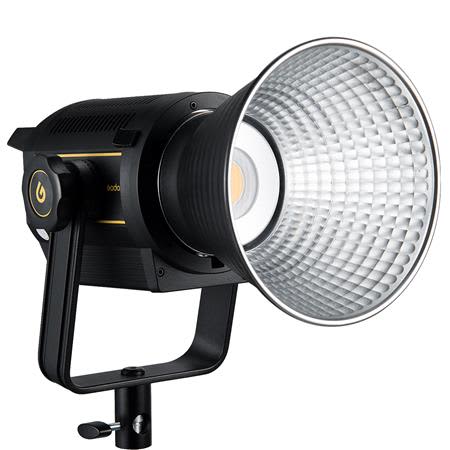 | Godox VL150 LED Light | |
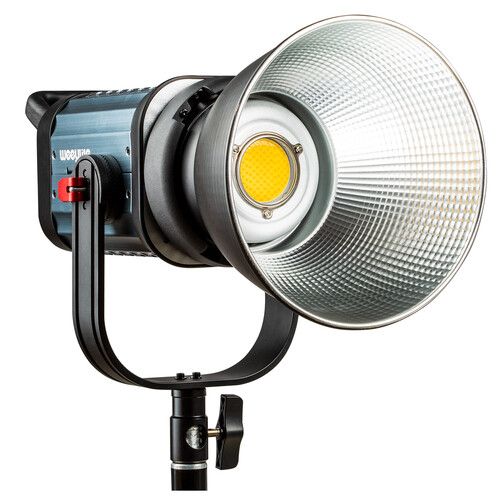 | Weeylite Ninja 400 LED Light |
Why 150 watts is the sweet spot
Continuous LED lights are made in a range of wattages: 60 watts, 80 watts, 120 watts, 150 watts, and higher. Generally speaking, the higher the wattage, the brighter the light, the higher the price.
You may be tempted then when buying your first continuous LED light to purchase a cheaper, lower wattage model. For example, the 60-watt Godox SL-60W. The SL-60W is a good light for a variety of creative applications, but its lower wattage limits its long-term usefulness.
For example, mount a softbox on the 60W, and light output is not only softened but diminished. The light must then be positioned closer to a subject to achieve proper exposure, which then requires the camera to be positioned closer to keep the light out of frame.

In short, wider shots require higher wattage lights.
Both the Godox VL150 and Ninja 400 provide 150 watts of power, which is two-and-a-half times the brightness of the SL-60W. In addition to enabling increased distance between the light and a subject, higher wattage and brightness opens the door to more creative lighting techniques (eg, layers of diffusion, book lights, spotlights, and so on).
For me, 150 watts is the sweet spot. It’s bright enough to do just about everything, and when I don’t need to use the light at full power (which is 99% of the time), I turn the brightness down low.
And that’s the fantastic thing about higher wattage lights. You may not regularly use all 150 watts, but when you need it, it’s there.
Similarities between the Godox VL150 and Weeylite Ninja 400
In addition to 150 watts of power, the Godox VL150 and Weeylite Ninja 400 are nearly identical lights. There are however a couple of key differences, but let’s first run through everything they share in common.
- Both are continuous LED lights. Turn them on and they stay on.
- Both have high CRI values at or above 95 for optimum color accuracy.
- Both have industry-standard Bowens mounts for attaching modifiers.
- Both include u-brackets that can be mounted to light stands or C-stands.
- Both are constructed using aircraft-grade aluminum and hard plastics.
- Both come with reflectors to increase light output.
- Both are controlled and powered through an external control unit.
- Both provide variable, step-less brightness between 0 and 100 percent.
- Both are powered through an outlet or with a single V-mount battery (sold separately).
- Both provide 16 channels and 6 groups for wireless grouping and control.
- Both have quiet internal fans for minimal interference when recording audio.
- Both include remote controls and free apps for iOS and Android.
- Both come with padded cases for storage and travel.
Besides their brightness, what I like most about these lights is how quiet they are. Their well-ventilated hardware expels heat naturally, without needing to constantly run their internal fans. And even when their fans do automatically turn on, very little noise is generated. This means live microphones positioned near both lights should pick up little to no noise.
Also nice, the control units have memory, so when you power both lights on and off they remember your last-used settings. A super helpful feature for those with fixed setups who shoot the same types of videos over and over.
Differences between the Godox VL150 and Weeylite Ninja 400
Now let’s take a look at the major and minor differences between these lights.
Color temperature
The Godox VL150 outputs light at a fixed color temperature of 5600 kelvin. The Weeylite Ninja 400 outputs light at a range of color temperatures between 2500 and 8500 kelvin. In technical lingo, this means the VL150 is a daylight balanced light, while the Ninja 400 is a bi-color light.
If you’re a photographer, think of them as prime and variable zoom lenses. Like a prime lens, the Godox VL150 is optimized for one temperature of light at every brightness level. The Ninja 400 — like a variable zoom lens — is optimized for variability and convenience.
That means in a head-to-head matchup between the Godox VL150 and the Ninja 400, with both lights outputting light at 5600 kelvin, the Godox VL150 appears more “correct” and neutral. The Ninja 400 is very similar but has a slight magenta color cast.
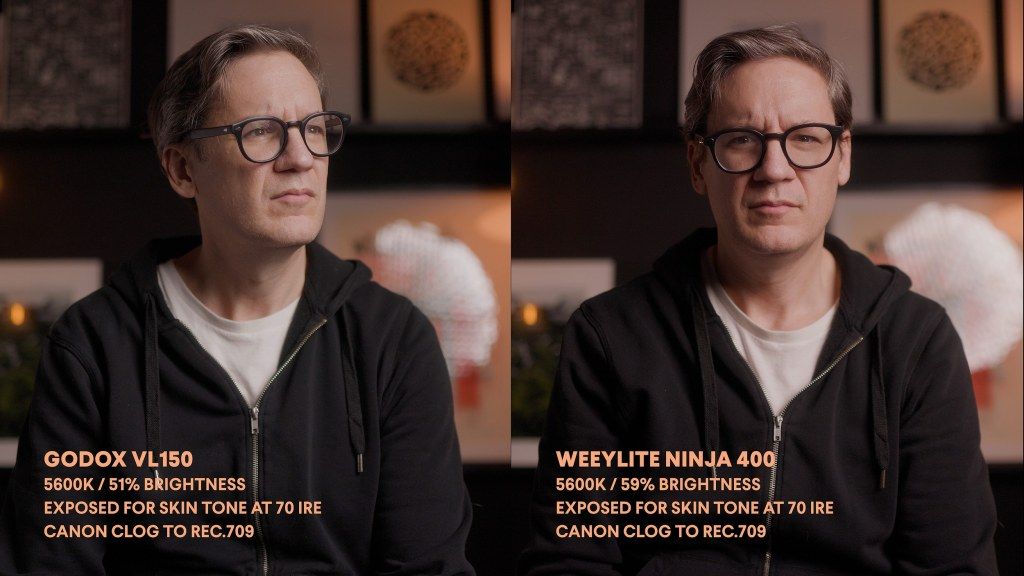
Does that make the Godox VL150 a better light than the Ninja 400? Well, that answer depends on how you intend to use the lights, and how important color accuracy is to the type of photo/video work you create.
For example, some photographers and filmmakers may value creative flexibility over accuracy (and besides, color cast can typically be fixed quite easily in post). The Godox VL150 can only produce a single temperature of light, while Ninja 400 can be used at 2500 kelvin to resemble vintage tungsten light, 8500 kelvin for blue-hued moonlight coming through a window, or any value in-between to match other light sources in your scene.
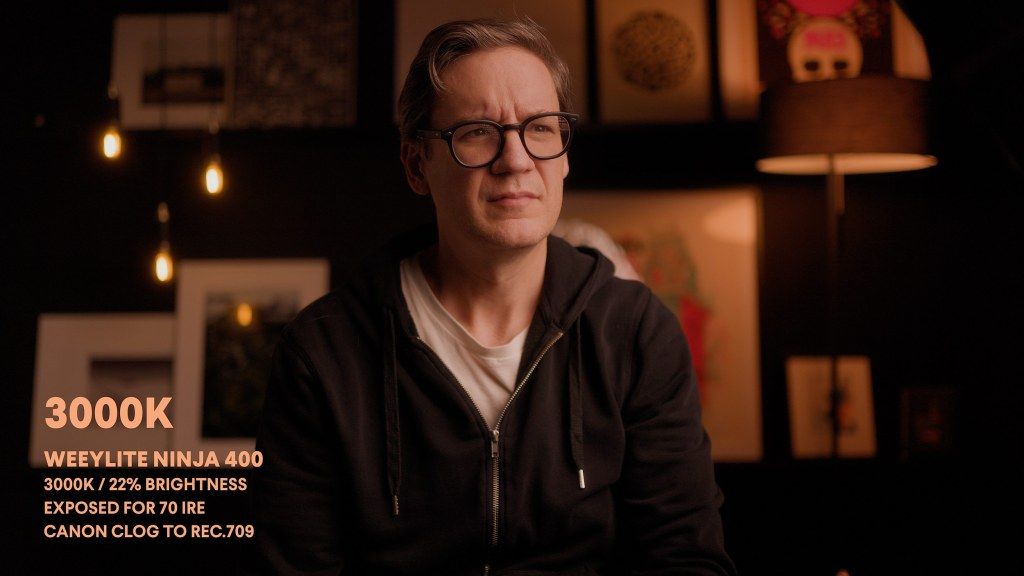
Low brightness values
Another key difference between the Godox VL150 and Weeylite Ninja 400 is how bright they are at their lowest brightness values. With both lights set to 1 percent brightness, the Godox VL150 is noticeably brighter than the Ninja 400.
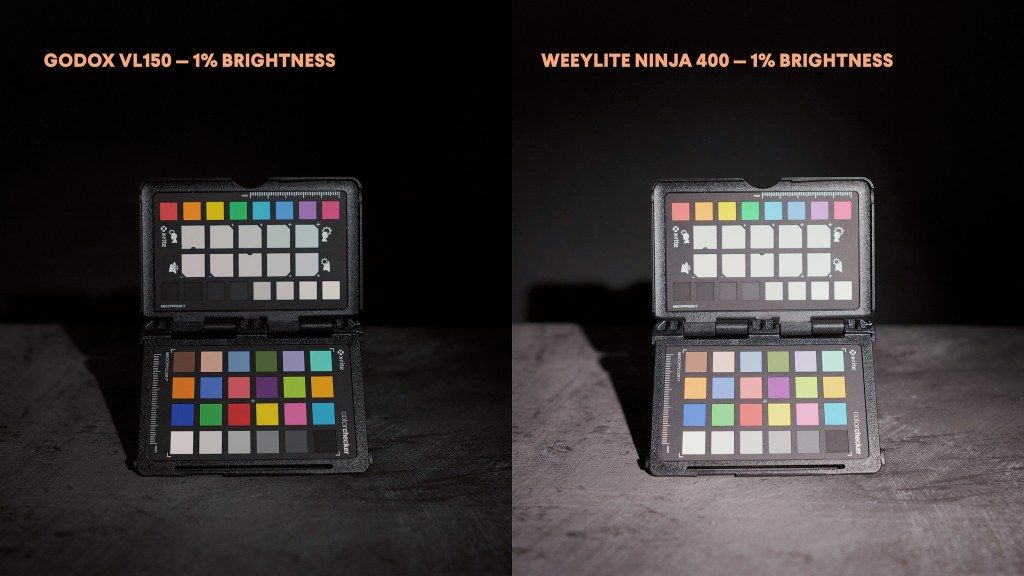
With both 150-watt lights set to 1 percent, it may seem strange that the Ninja 400 is so much brighter. What’s happening here is that the effective brightness range of the Ninja 400 is 20-100 percent. In other words, 1 percent brightness on the Ninja 400 is roughly equivalent to 20 percent brightness on the VL150.
This means the VL150 has more latitude at the low end of the brightness scale. This translates into needing to less frequently move the light further away from a subject when light output is too bright, as you would more often with the Ninja 400.
Minor differences
Tilt on the VL150 is locked using a circular knob while the Ninja 400 uses a latch. The latch design of the Ninja 400 makes adjusting tilt much faster and simpler comparatively.
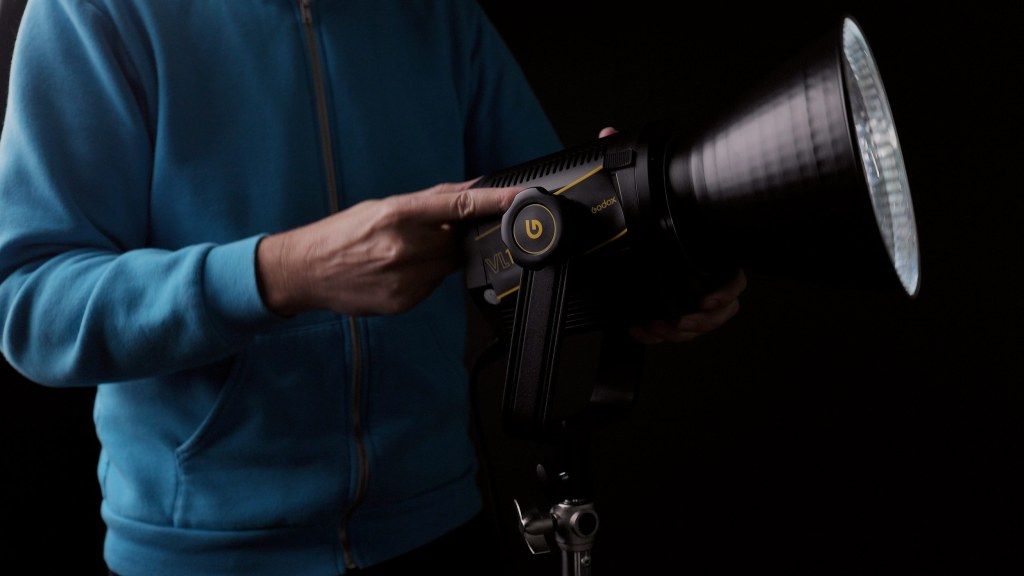
The Ninja 400 has DMX inputs and outputs, which means the light can be plugged into a console for professional setups, while the VL150 does not offer DMX.
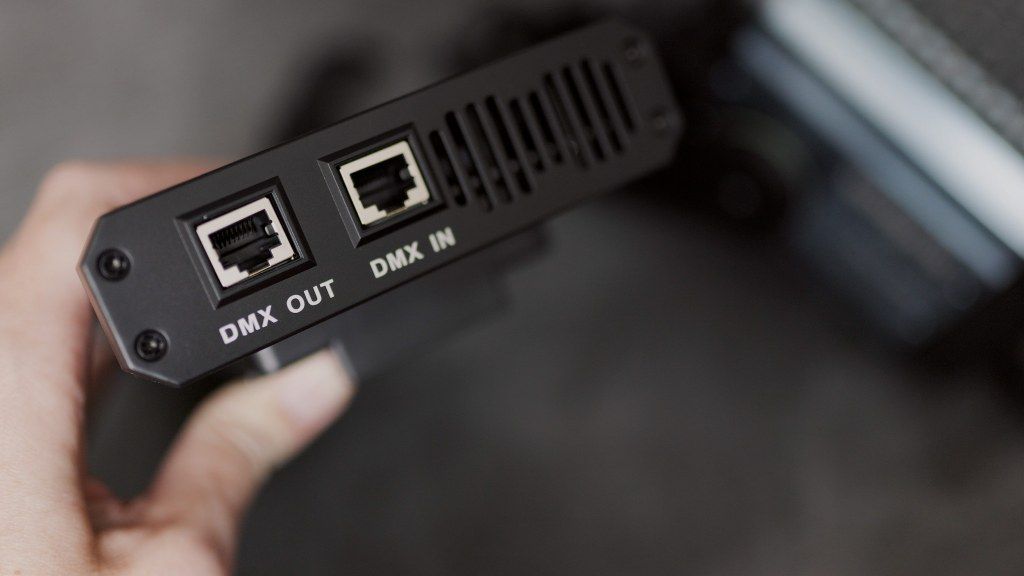
As mentioned earlier, both the VL150 and Ninja 400 offer free iOS and Android mobile apps. Each app controls power, brightness level, and grouping if you have more than one Bluetooth compatible light from the same brand. Because the Ninja 400 is bi-color, its app also controls color temperature through a variable slider or presets.
While functional, the design and user experience of both apps could be improved, but of the two, the Godox app needs the most work. Brightness levels between the control unit and the Godox app are not synced. You have to manually set the brightness of the VL150 control unit to the value of the app — or vice versa — in order for them to correctly adjust brightness in tandem.
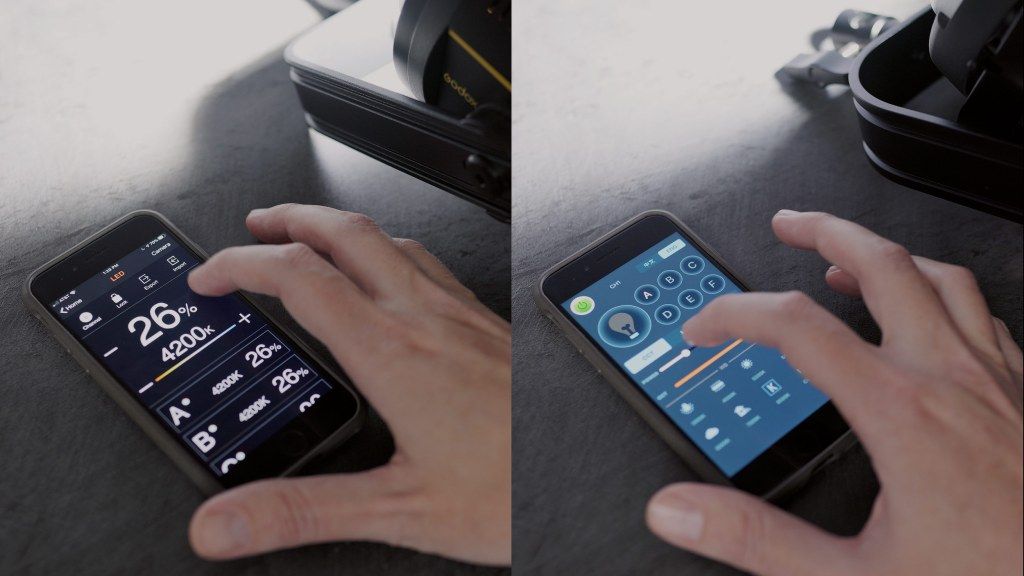
Additionally, brightness with the Godox mobile app can only be turned down to 10 percent. For brightness levels lower than 10, you have to use the control unit.
Summary
Overall, both the Godox VL150 and Weeylite Ninja 400 are solid lights sold at more affordable prices than other brands. Also of interest, the Ninja 400 is the only bi-color, continuous LED light offering this level of wattage at this price point.
Both lights are super quiet, well constructed, and provide more than enough light for content creators, small businesses, or solo photographers/videographers who want to maximize their budget.
The main difference to consider then is how important color temperature and low brightness levels are to the type of work you’re doing. If you mostly do product photography or talking-head-style video, the 5600 kelvin Godox VL150 may be simpler and better for your work. If you’re a filmmaker, architectural/interior photographer or someone who just wants more creative latitude and control with their lighting, the Weeylite Ninja 400 will give you more of what you need.
Video
A video version of this review is embedded below.
Disclosure
In full disclosure, I purchased the Godox VL150 with my own money, but the Weeylite Ninja 400 was provided by Weeylite for the purposes of this review. Neither Godox nor Weeylite previewed this review prior to publication.



